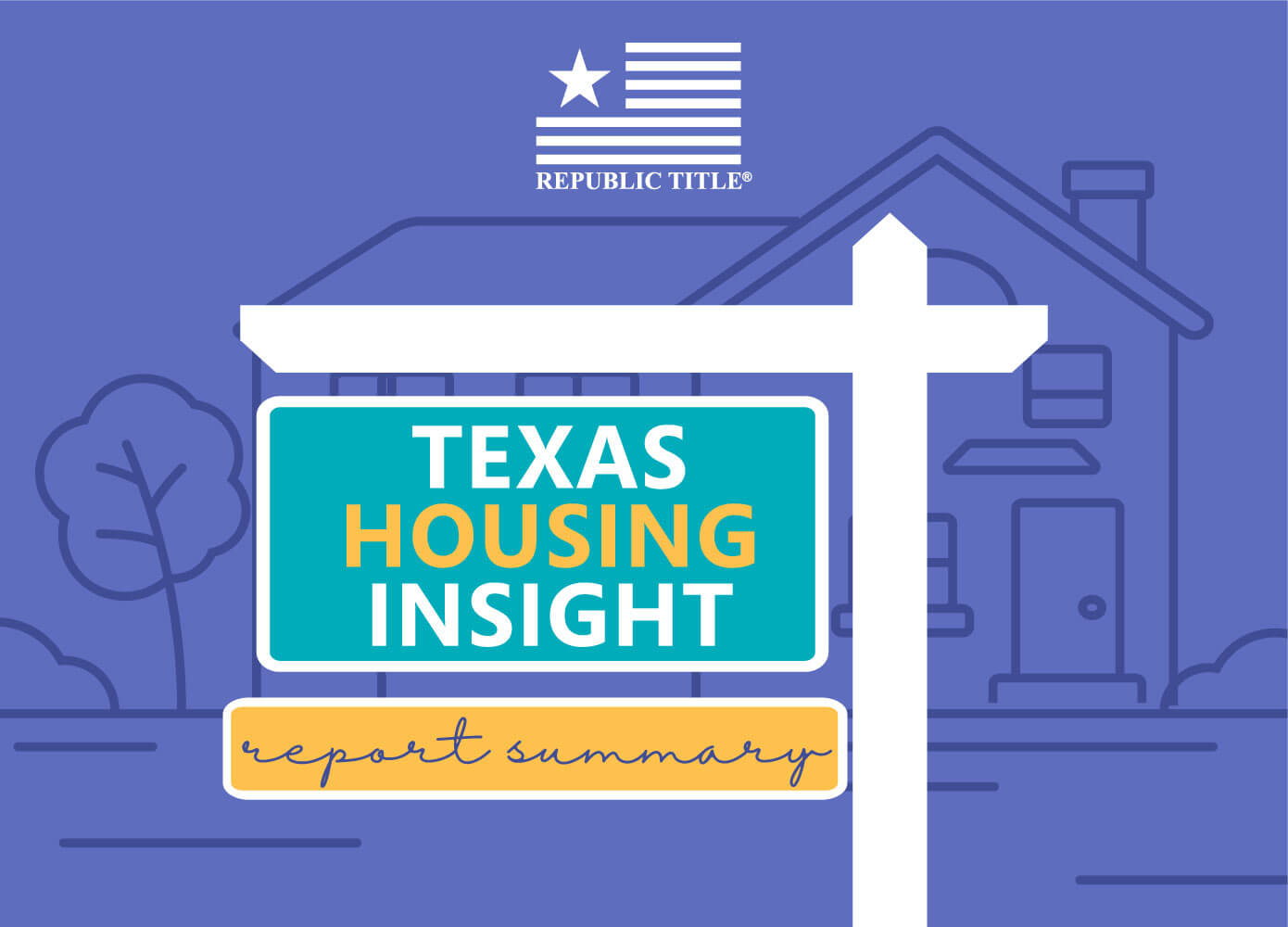Here is the January 2020 Summary from Texas A&M Real Estate Center.

January 2020 Summary
Please note this review does not account for the impacts of the COVID-19 outbreak but reflects the market through January 2020.
Texas housing sales stabilized in January after reaching a record high the previous month. Steady employment growth and falling mortgage interest rates continued to support housing demand, as exemplified by increased mortgage applications and a downtick in the average days on market. Inventories were constrained, especially for homes priced less than $300,000, but renewed permit issuance indicates positive construction activity in 2020. Although home-price appreciation has moderated over the past few years, tight supply levels put additional affordability pressure on top of lackluster average wage growth. Due to the coronavirus outbreak, there may be disruptions to building material supply chains and the visiting and showing of homes for sale, threatening the Texas housing market. These effects will probably be reflected in the second quarter of the year.
Supply*
The Texas Residential Construction Cycle (Coincident) Index, which measures current construction activity, balanced after trending upward for four straight months as construction employment growth slowed. The Residential Construction Leading Index dipped slightly as housing starts decreased but hovered around the post-crisis high, suggesting solid levels of construction in the coming months.
Fourth quarter private bank loan data corroborated stable construction activity at the end of the year, increasing 0.8 percent quarter over quarter (QOQ). Multifamily investment climbed throughout 2019, rising 2.1 percent to $8.6 billion during 4Q2019. The one-to-four unit sector, however, stalled through the second half of the year after reaching a cycle-high in 2Q2019 of $7.7 billion.
Single-family construction permits started the year strong, increasing 3.2 percent to a post-recessionary high after a sluggish end to 2019. Texas led the nation with 11,100 nonseasonally adjusted permits, accounting for more than 17 percent of the U.S. total but ranking eighth in per capita issuance. At the metropolitan level, Houston topped the list with 3,565 permits, followed by DFW with 3,370. Austin permits increased to 1,472 while maintaining the highest per capita rate in the Texas Urban Triangle. In San Antonio, monthly permits surged to 846. Texas’ multifamily sector increased issuance in January but failed to recover to levels reached in 3Q2019 after falling at year end.
Decreased permitting activity in the last months of 2019 weighed on total Texas housing starts in January, falling 7.3 percent amid a drawback in the single-family sector. The trend, however, remained on a strong upward trajectory. Meanwhile, single-family private construction values dropped 11.1 percent to their lowest level since June 2019 after adjusting for inflation, corroborating loan value data. After reaching an all-time high in October, San Antonio construction values trended downward, comprising half of the monthly decrease. The metric declined for the second straight month in Austin and DFW. Houston values, however, reached an annual high after improving 3.3 percent.
Strong sales activity chipped away at the state’s supply of active listings. Texas’ months of inventory (MOI) fell for the third consecutive month to 3.4 months. A total MOI around six months is considered a balanced housing market. The MOI for homes priced less than $300,000 fell to 2.7 months, while inventory for luxury homes (those priced more than $500,000) remained elevated at eight months. This disparity exemplifies the shortage of affordable housing, although efforts have been made to more closely match demand and supply.
Inventory in the major metros was even more constrained than the statewide average. Austin’s MOI fell to an all-time low of two months, while the Dallas and Fort Worth MOIs ticked down to 2.9 and 2.4 months, respectively. San Antonio’s metric registered less than 3.4 months as inventory for homes priced less than $300,000 dropped to levels unseen in more than a year after gradual improvement during 4Q2019. Houston was the exception as the metro’s supply of active listings continued to rise despite strong sales activity, boosting inventory to 3.9 months.
Demand
Total housing sales during January flattened just below record levels reached at year end. Nonseasonally adjusted sales for home priced at the lower end of the market (less than $200,000), however, were well below the series’ January historical average. Sales volumes within the price range fell year over year (YOY) despite lower interest rates and solid demand fundamentals amid inventory constraints at the lower end of the market. Homes priced less than $200,000 constituted 36 percent of total monthly sales versus 72 percent in 2011.
Sales activity in the major metros cooled after accelerating during the fourth quarter. Houston sales corrected downward 2.2 percent from an all-time high in December, while Dallas monthly sales stabilized at a record 6,000 after increasing 11.3 percent at year end. In Austin, sales for homes priced $200,000-$400,000 stalled as inventory tightened after strong activity in 2019, pulling overall sales down 1.3 percent in the MSA. San Antonio extended a steady upward trend, although Fort Worth sales volumes flattened at their annual average.
Texas’ average days on market (DOM) stabilized at 59 days, indicating healthy demand. San Antonio and Houston’s DOMs hovered around the statewide level at 59 and 58 days, respectively. In Austin, the metric averaged 51 days, shedding ten days from its year-ago level. The DOMs in Dallas and Fort Worth trended upward for most of 2019 after low levels between 2015-17 but showed signs of stabilizing at 55 and 44 days, respectively.
After speculations of a U.S.-China trade truce supported modest increases in interest rates during 4Q2019, U.S.-Iranian military strikes and initial news of the coronavirus outbreak pulled rates down in January. Current economic fundamentals at the state and national level, however, remain healthy. The ten-year U.S. Treasury bond yield fell below 1.8 percent, while the Federal Home Loan Mortgage Corporation’s 30-year fixed-rate decreased to 3.6 percent. After declining the previous month, mortgage applications for home purchases increased 9.1 percent. Refinance activity stumbled on the month, but the overall trend remained positive considering refinance mortgage applications nearly tripled during 2019.
Prices
The Texas median home price flattened to $247,200, although YOY growth hovered around 5.6 percent for the second straight month amid strong sales and inventory contractions. The nationwide existing-home median price increased 6.8 percent YOY to $283,200 compared with Texas’ existing-home price of $239,800. The gap between the U.S. and Texas new-home median price ($352,600 and $293,000, respectively) widened to $59,000 in January after averaging $30,000 in 2019.
Movements in the median home price varied on the metropolitan level. Houston and Austin each shed $1,900 off their median home price, pulling the metric down to $247,800 and $320,400, respectively, while the median price in San Antonio steadied at $236,200. North Texas, however, registered $5,800 and $9,000 increases in Dallas ($302,800) and Fort Worth ($254,200), respectively. The rise in the former may be explained by the recent surge in sales whereas the latter’s price hike is likely an upward correction after falling $7,600 over the previous two months.
The Texas Repeat Sales Home Price Index, a better measure of changes in single-family home values, provides insight into how Texas home prices evolve. The index indicated more moderate annual home price appreciation of 3.6 percent. Strong demand and dwindling supply pushed Austin’s index up 5.9 percent YOY. Home prices in Houston and Fort Worth increased at a pace of 2.7 and 3.6 percent, respectively. Meanwhile, the Dallas and San Antonio indexes rose just 2.4 percent YOY each. Except for in Austin, home price growth in the major metros has stabilized at more moderate levels than during 2014-17. Persistent wage improvement that outpaces home price appreciation, however, is necessary to maintain overall housing affordability, which remains a challenge to the Texas home market.
Source – James P. Gaines, Luis B. Torres, Wesley Miller, and Paige Silva (March 10, 2020) https://www.recenter.tamu.edu/articles/technical-report/Texas-Housing-In…









